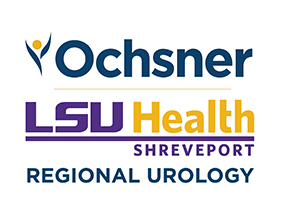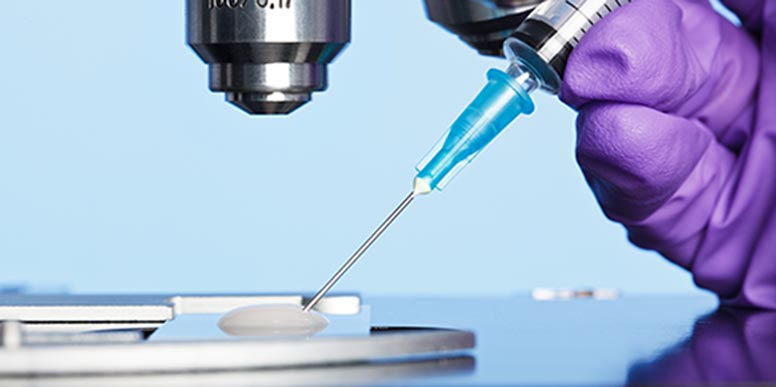A sperm extraction is a surgical procedure performed to retrieve sperm from the testicle or the epididymis for future in vitro fertilization (IVF). There are many different types of procedures utilized to retrieve sperm.
Hidden
Hidden text
Percutaneous Epididymal Sperm Aspiration (PESA)
This is a minor surgical procedure typically performed on men who have had previous vasectomy and need sperm extracted for IVF with a female partner. It does not require general anesthesia and typically results in high quality sperm, but there may not be enough remaining sperm to freeze should IVF fail and more cycles are needed.
Occasionally, the physician will need to make a small surgical incision into the testicle (TESE) to get sperm if no sperm are found at the time of PESA or if sperm quality is poor.
Microsurgical Epididymal Sperm Aspiration (MESA)
Requires general anesthesia and surgeon who is trained in microsurgery. Microscopic incision is made in the epididymis (area to the side of testicle where sperm mature) and sperm are obtained for IVF. Quality of sperm is typically excellent with ample sperm retrieved. Unused sperm may be frozen and used at a later date if needed.
Testicular Sperm Extraction (TESE)
This is an open surgical biopsy of the testicle typically done in men who have had a vasectomy and would like to retrieve sperm for IVF. Anesthesia is required. A small opening is made in the scrotum and testicle. A small amount of testicular tissue is then removed and processed by a lab. Some of the sperm will be used for IVF and the rest can be frozen and used at later date if needed. Usually results in ample number of sperm so that repeat procedures can be avoided.
Generally speaking, there are no significant differences in IVF outcomes if frozen sperm are used instead of fresh sperm. We will defer to the REI (Reproductive Endocrinologist) regarding which type they prefer.
Testicular Sperm Aspiration (TESA)
This is a percutaneous approach and is less invasive than TESE. Testicular tissue and sperm are typically obtained through a small needle puncture in the scrotal skin. General anesthesia is usually not necessary and typically results in sufficient quantity/quality of sperm for IVF. Leftover sperm can then be frozen if more rounds of IVF are needed.
Mirco-Testicular Sperm Extraction (Micro-TESE)
What is a Micro-TESE?
Microsurgical testicular sperm extraction (Micro-TESE) is a surgical procedure requiring general anesthesia that is performed in men with no sperm present on semen testing (azoospermia). In these men, there is an issue with production, not obstruction.
How is it performed?
It typically takes about 2 hours to perform. A small incision is made in each testicle and the urologist uses an operative microscope to carefully look through each testicle under high magnification for pockets of sperm production.
Typically, an embryologist (fertility specialist) is present in the operating room to assist as well. If sperm are found, the embryologist will take the testicular tissue back to their lab for processing and freezing. The sperm could then be potentially used for in vitro fertilization at a later date. Pregnancy cannot be guaranteed.
What are the success rates?
Success rates can vary greatly. Success is defined as the ability to find and harvest sperm for freezing. These rates can approach 50% or greater for some men. Many times, men will have undergone a testicular biopsy prior to undergoing a micro-TESE. Doing a testicular biopsy first helps to identify the cause for low sperm production and helps to estimate the probability of finding sperm at the time of micro-TESE. Most insurances will cover a testicular biopsy.
What causes men not to produce sperm?
The most men will elect to undergo genetics testing prior to a testicular biopsy or micro-TESE.
Genetic testing consisting of Y-chromosome microdeletion (YCMD) and a Karyotype (examination of chromosomes). The karyotype is looking for a syndrome called Klinefelter’s. Men with either Klinefelter’s or YCMD typically will not have sperm in the ejaculate. If either of these genetic tests are positive, then your urologist will review how this will affect plans moving forward.
Testicular biopsies can also be helpful. Men showing hypospermatogenesis (low sperm production) on biopsy will have much higher success rates of at the time of micro-TESE. Other patterns such as Sertoli cell only, maturation arrest, or tubular sclerosis will typically have much lower success rates at micro-TESE.
How can I optimize my chances?
Your urologist will typically have evaluated your male hormones such as testosterone prior. Many men will need to be on an estrogen blocker such as clomiphene citrate. This helps the testicles make more of their own testosterone and thereby improves the environment when sperm are produced.
Additionally, medications like FSH or hCG may also be needed. These medications tend to be more expensive. Your urologist will help you decide which medications are best for you. Typically, patients will need to be on these medications for at least 3 months prior to micro-TESE. This helps to make sure enough time has passed for optimization as it takes 72 days for a full cycle of sperm to mature.
What about the cost?
Regional Urology offers very competitive pricing. This cost is procedure specific. These procedures are not covered by insurance, and we offer package pricing (cost of general anesthesia, facility fee, and surgeon fee).
We encourage patients to inquire about pricing by calling 318-683-0411 ext 178 and asking for Male Fertility Coordinator.
What about the recovery process?
Mild pain and swelling are normal for a day or two. Most men will want to take a week off work. Ok to shower. No heavy lifting great than 10lbs for two weeks. Ok to resume sexual activity after two weeks. Men need to wear supportive briefs for at least two weeks after.
What About the Cost of a Sperm Extraction?
Regional Urology offers very competitive pricing. This cost is procedure-specific. These procedures are typically NOT covered by insurance and we offer package pricing (cost of general anesthesia, facility fee, and surgeon fee).
We encourage patients to inquire about pricing before or after their initial consultation in order to receive the most up to date pricing package by calling 318-683-0411 and asking for Male Fertility Coordinator.
Postoperative Details
Please alternate ice packs to scrotal incisions for the next 24 hours.
- Ok to remove scrotal support the following day at noon and then shower. No tub baths as stitches in the skin are absorbable.
- No heavy lifting (greater than 10 lbs) for the next 48 hrs. After that it is ok to ease back into activity. Common sense rules apply: if it hurts, don’t do it. Please wear supportive briefs until follow up appointment.
- Swelling, mild bruising, and discomfort are very normal.
- Most men require narcotic pain tablets for 48-72 hours.
- Please call the office if you do not have a follow up appointment scheduled. We generally like to see you back in the office around 2 weeks following your procedure.
- If you had a micro-TESE: spasms of testicular cord occur in about 20% of men. This causes a sudden increase in the pain within the testicle, but it is not dangerous. Please apply warm compresses to the groin area where the cord is located and take the prescribed narcotic pain medication. This will help to ease the spasms.
Patient Resources:


